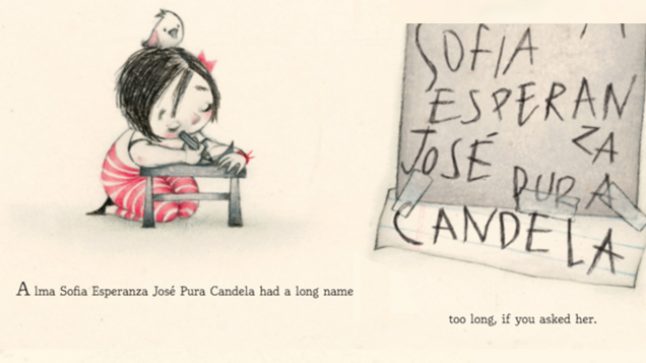Series: Book Ideas
What’s So “Big” about Measurement Concepts for Young Children?

In real life, we often want to know which is bigger? and who has more? For children it can be very important because they feel that things should be fair. Bigness is often associated with the amount or size of a good thing that is being shared with them, whether it is the number of cookies or the size of the cookie. But those are two different types of “big,” right?
Young children often confuse different ways of describing and comparing size and amount. They think someone who is taller must be older. Most children will also say a tall, narrow glass is bigger than a short, wide one, even though they hold the same amount of water. They need to learn to name the exact attribute they are comparing.
Books are great jumping off spots for exploring measurement concepts and what it means to be “big.” In the award-winning Alma and How She Got Her Name by Juana Martinez-Neal, a father explains to his daughter why she ended up with 6 names. The length of names is highly interesting to young children as they begin to read and write them. You can use connecting blocks of the same size to make name towers for each of Alma’s names. Make sure you use one block for each letter. Then let the discussion begin:
Do any of Alma’s many names have the same number of letters as Alma?
The longest of Alma’s 6 names is Esperanza: What two of her other names could you put together to end up with 9 letters?
Have each child make a name tower using their own first name. Then, children can compare their names to Alma’s names and to each other’s.
How many children’s names are the same length as one of Alma’s? Does anyone have a shorter name than Alma or a longer name than Esperanza?
What if you clap syllables—does that change whose name is longer? (Max and Ava both have 3 letters but Ava has 2 syllables and Max has 1.)
Another great entry point for this concept is the Three Little Pigs, of which there are many great versions. Although the wolf is bigger than the pigs, the third little pig is smarter. Explain what you think is better, to be bigger or smarter. The first two pigs built their houses faster but the third pig’s house was stronger. Explain what you think is better, to finish faster or to make something stronger. Also, you can extend the discussion by building some houses. Work together or in teams. Choose the same number of blocks, maybe 6 or 10, and then use them to build different kinds of houses and discuss in what ways they are “big.” There are many different ways to be big that you can create:
This house is higher but is not wider.
This house has one big room.
This one is wider but is not very tall.
This one has two smaller rooms.
Along the way you can engage children with descriptive language that helps children become more precise in describing and comparing sizes. The ability to use increasingly precise measurement language moves children from “big” to knowing what kind of big such as longer, taller, wider, older, and so on.